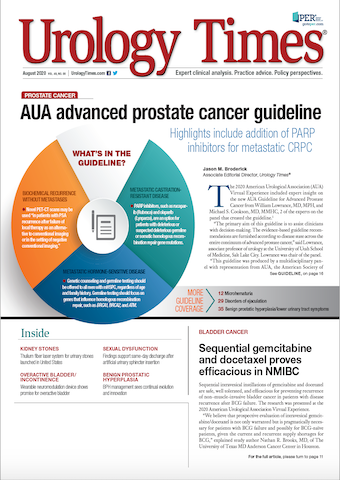Publication
Article
Urology Times Journal
Consensus guideline for advanced prostate cancer released by AUA, ASTRO, and SUO
Author(s):
The American Urological Association, American Society for Radiation Oncology, and Society of Urologic Oncology have released a joint guideline for advanced prostate cancer to address the growing treatment options and complexity of the paradigm.
A new guideline for the diagnosis and treatment of patients with advanced prostate has been released through a combined effort of the American Urological Association (AUA), American Society for Radiation Oncology (ASTRO), and Society of Urologic Oncology (SUO).1,2
The guideline includes 38 clinical recommendations spanning the entire spectrum of advanced prostate cancer from PSA recurrence following use of all available local treatments to full metastatic disease.
William Lowrance, MD, MPH

"For the past several years, the prostate cancer landscape has been rapidly evolving due to changes in PSA screening standards, as well as the approval of new classes of treatment options for use in various prostate cancer disease states," William Lowrance, MD, MPH, chair of the guideline panel, stated in a press release. "This guideline is comprised of clinical recommendations based on this new evidence and aims to further support the medical community and patients as they navigate through the various stages of this disease."
Members of the American Society of Clinical Oncology were included on the guideline panel. Key categories covered in the guidelines include Early Evaluation and Counseling; Biochemical Recurrence without Metastatic Disease after Exhaustion of Local Treatment Options; Metastatic Hormone-Sensitive Prostate Cancer; Non-Metastatic Castration-Resistant Prostate Cancer; Metastatic Castration-Resistant Prostate Cancer; and Bone Health.
The panel of experts who wrote the guidelines also stressed that given the expansion and complexity of the armamentarium for advanced prostate cancer, multidisciplinary teams are essential for optimal patient management. According to the panel, all teams should include urologists, medical oncologists, and radiation oncologists, with additional specialists joining as appropriate, including genitourinary pathology, genetic counseling, palliative care, and holistic specialists, and primary care.
One of the notable guideline recommendations demonstrating the growing complexity of the prostate cancer treatment paradigm is the indication that, “Clinicians should offer a PARP inhibitor to patients with deleterious or suspected deleterious germline or somatic homologous recombination repair gene-mutated metastatic castration-resistant prostate cancer (mCRPC) following prior treatment with enzalutamide or abiraterone acetate, and/or a taxane-based chemotherapy. Platinum based chemotherapy may be offered as an alternative for patients who cannot use or obtain a PARP inhibitor.”
This recommendation comes on the heels of 2 recent FDA approvals of PARP inhibitors for the treatment of patients with mCRPC. In May 2020, the FDA approved rucaparib (Rubraca) for the treatment of adult patients with BRCA mutation (germline and/or somatic)—associated mCRPC who have been treated with androgen receptor–directed therapy and a taxane-based chemotherapy. The approval was based on data from the phase 2 TRITON2 study, in which the confirmed objective response rate was 44% in a cohort of 62 patients with BRCA-mutated mCRPC.3
Also in May 2020, the FDA approved olaparib (Lynparza) for the treatment of adult patients with deleterious or suspected deleterious germline or somatic homologous recombination repair (HRR) gene-mutated mCRPC who have progressed following prior treatment with enzalutamide (Xtandi) or abiraterone acetate (Zytiga). The approval was supported by the phase 3 PROfound trial, in which the risk of disease progression or death was reduced by 66% with olaparib compared with abiraterone acetate or enzalutamide (HR, 0.34; P <.0001) in patients with BRCA1/2- or ATM-mutant mCRPC.4
Adam S. Kibel, MD

“We were due for an update on the guidelines for advanced prostate cancer. Multiple new treatments have been developed over the past few years and there was a need to put those treatments into context for urologists and radiation oncologists,” Adam S. Kibel, MD, a member of the guideline panel, said in an interview with Urology Times.
“The key new things are the integration of imaging, and the use (in some cases) of biomarkers. Even the fact that this is a guideline for ‘advanced prostate cancer’ and the prior one was for ‘castrate-resistant prostate cancer’ shows how systemic treatment indications are moving to earlier disease states where they will provide enhanced survival,” added Kibel, chief of urology at Brigham and Women's Hospital and Dana-Farber/Brigham and Women's Cancer Center.
The complete guideline can be accessed on the AUA's website.
In the press release, the AUA reported that this year approximately 192,000 prostate cancer cases will be diagnosed in the United States, and more than 33,000 US males will die of the disease.
References
1. Leading Organizations Release New Clinical Guideline on Advanced Prostate Cancer. Published online June 25, 2020. https://prn.to/3dDiK1X. Accessed June 25, 2020.
2. Lowrance W, Breau R, Chou R, et al. Advanced Prostate Cancer: AUA/ASTRO/SUO Guideline. American Urological Association. Published June 25, 2020. https://bit.ly/2BCwvkk. Accessed June 25, 2020.
3. Rubraca® (Rucaparib) Approved In The U.S. As Monotherapy Treatment For Patients With BRCA1/2-Mutant, Metastatic Castration-Resistant Prostate Cancer (MCRPC) Who Have Been Treated With Androgen Receptor-Directed Therapy And A Taxane-Based Chemotherapy.Published May 15, 2020. https://bit.ly/2z0rMrK. Accessed June 25, 2020.
4. Lynparza Highlights of Prescribing Information. FDA. Updated May 19, 2020. https://bit.ly/2WLJt7u. Accessed June 25, 2020.

































